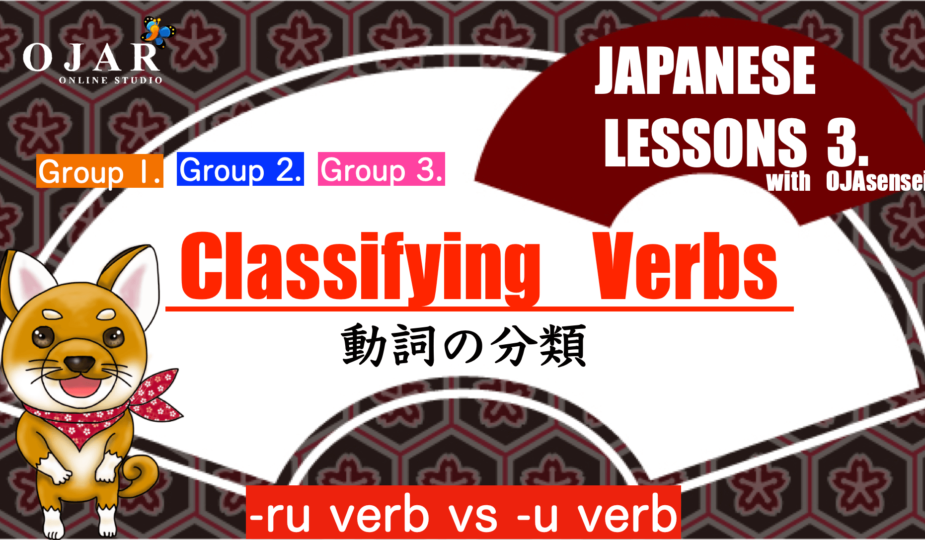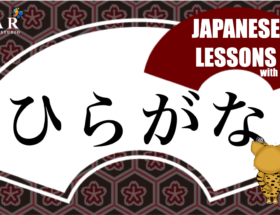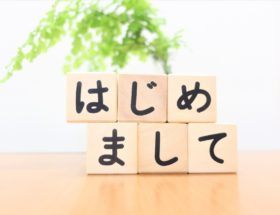Hi, ojachan is here 🙂 Today’s lesson is: Japanese Lesson 14. Verbs (with fully clear illustrations)
Don’t you want to know how to learn Japanese like Japanese kids? This lesson is meant for students that are beginners at Japanese.
A Dictionary of Basic Japanese Grammar
This is the best Grammar book.for beginner’s level of Japanese!
There are a lot of examples and clear explanations in English!
★ Level: Elementary
★ Genre: Grammar
★ Language: English is used for grammar explanations and translations of example sentences.
★ Number of entries: 206
★ Example sentences are written in kanji/kana with romanization.
I believe that you should be able to understand Japanese now.
Let’s learn about “How to classify verbs” to expand your Japanese expressions.
When I learned French, I was excited to learn “ the verb conjugations” because I could express a lot of things with just only memorizing ONE word.
I was a Japanese teacher for Japanese kids so I’m gonna try to teach you Japanese including a little knowledge of grammars of national learning. Of course I know that the way of approaching of Japanese which foreigners learn as a second language are different from Japanese which Japanese kids learn as a study.
Strictly speaking, I don’t have to teach Japanese which Japanese kids do so. (Actually I might be scolded by Japanese teachers for foreigners :p ) However, I think you should figure out the deeper reasons of the origins and the meaning of the words which you can’t find any Japanese textbooks for Japanese learners!
Let’s get started!
CONTENTS
What’s the verb?
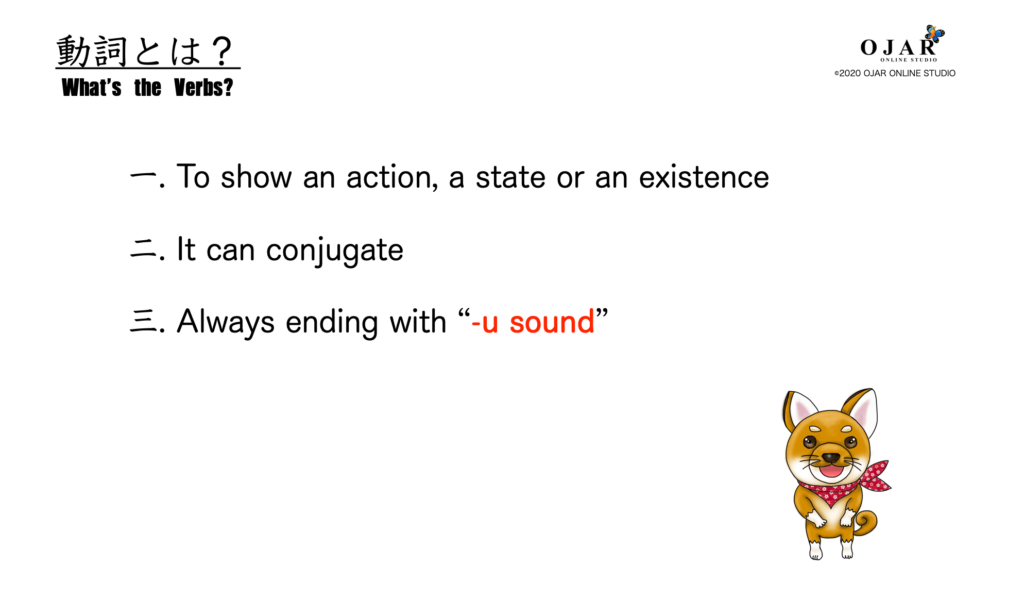
“Verb” is that it can show an action, a state, or an existence and can conjugate.
It’s very easy how to identify verbs in Japanese.
A Verb in Japanese always ends with “-u sound”.
For example:
| 動く ugoku 終わる owaru 言う iu |
-1024x597.png)
A Verb of Japanese consists of a stem and a suffix.
“A stem” is a part not to change and is called “語幹 gokan” in Japanese.
“A suffix” is a changeable part and is called “活用語尾 katsuyougobi” in Japanese.
So when you learn vocabulary verbs, you should learn “jisho – form” verbs because you can learn them easier eventually and verbs have conjugations.
Even if it’s easier for you to learn “masu – form” verbs but DO NOT learn from a “masu – form” verbs.
An Intransitive Verb and A Transitive Verb
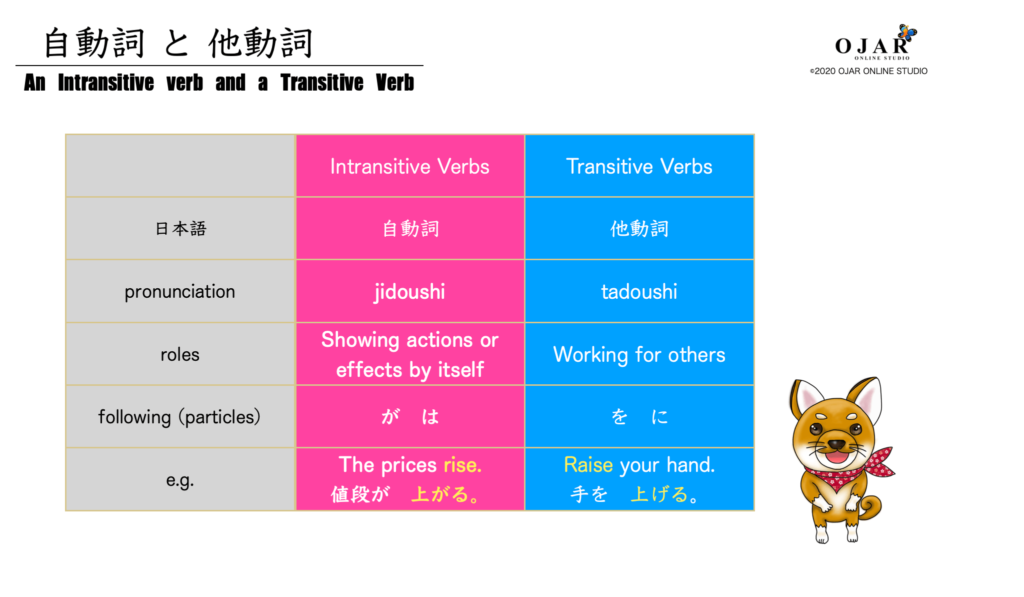
Memorizing verbs by classifying and understanding the difference between an intransitive verb and a transitive verb are very important.
The reason is because it’s essential knowledge to know the usage particle “を wo” and particle “が ga”.
An intransitive verb, which is called “自動詞 jidoushi”, can show an action or an effect by the subject.
While, a transitive verb, which is called “他動詞 tadoushi”, works for others.
Intransitive verbs can follow “が ga” or “は wa”, and transitive verbs follow “を wo” or “に ni”.
Here is the detail lesson “An Intransitive Verb vs A Transitive Verb” .
Conjugations of Verbs
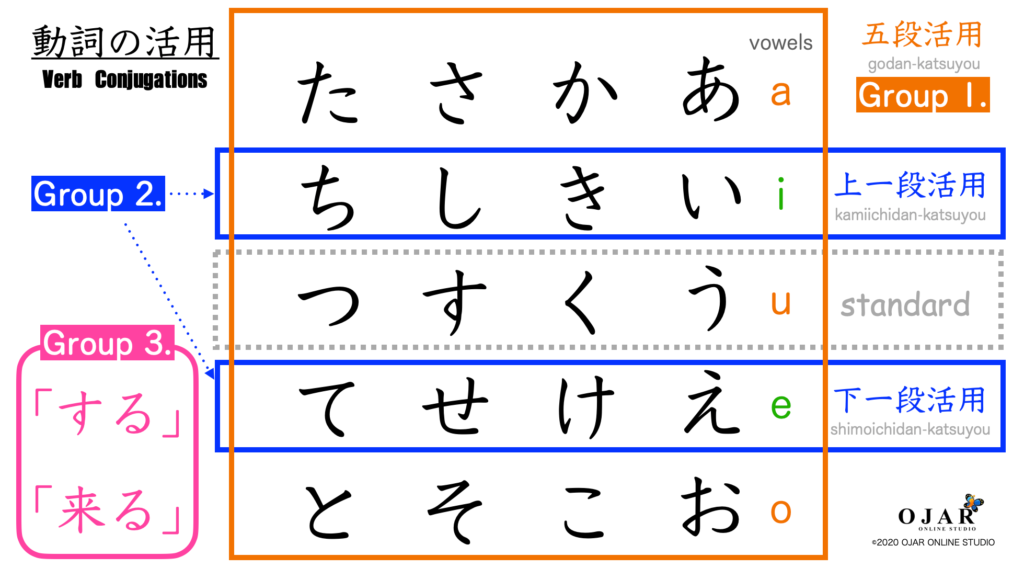
There are 3 groups of conjugations of verbs in Japanese.
| Group1 | Group2 | Group3 | |
|---|---|---|---|
| verbs | –u verb | -ru verb | 来る する |
| conjugation | vowel sounds (a i u e o) | –i sound – e sound | kuru and suru |
| in Japan | 五段活用 | 上一段活用 下一段活用 | カ行変格活用 サ行変格活用 |
| pronunciation | godan-katsuyou | kami-ichidan-katsuyou shimo-ichidan-katsuyou | KAgyou-henkaku-katsuyou SAgyou-henkaku-katsuyou |
Group 1 conjugate with “a,i,u,e,o – sounds”, so we call it “五段活用 godan-katsuyou”.
Group 2 conjugate with “ -i sound”, which is called “上一段活用 kami-ichidan-katsuyou”, and conjugate “-e sound”, which is called “下一段活用 shimo-ichidan-katsuyou”.
In Japanese textbooks, it is appeared as “一段活用 ichidan-katsuyou”.
The meanings of these “上一段” and “下一段” are based “-u sound” and we judge them whether they are one step upper or one step lower against “-u sound”.
Classifying Verbs
Can you classify these verbs to each group?
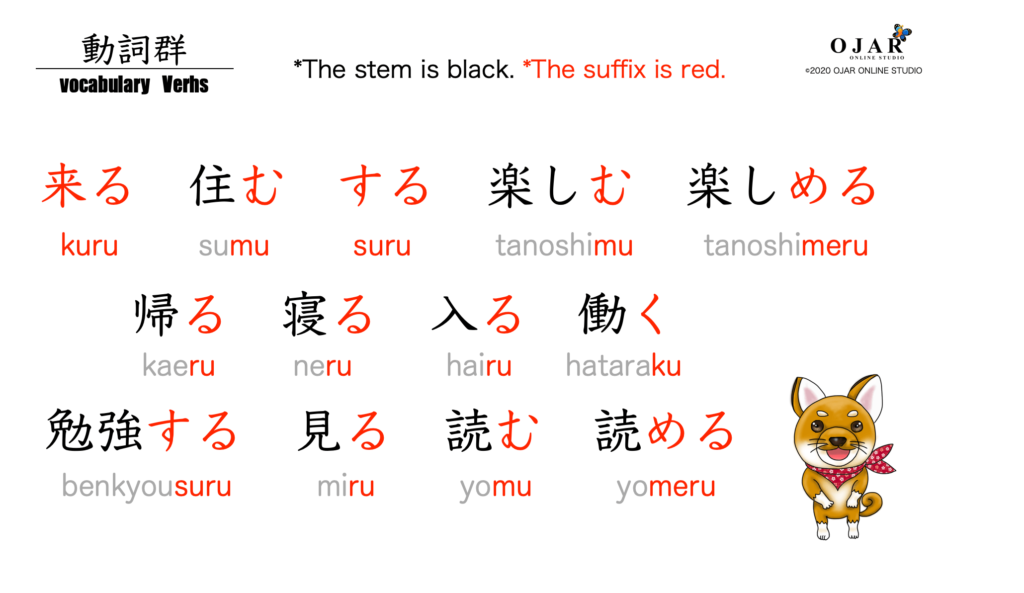
Let’s consider with me which groups they are from now on.
Group 3. “kuru” and “suru”
The first, “来る kuru” and “する suru” are only exceptions and are Group 3.
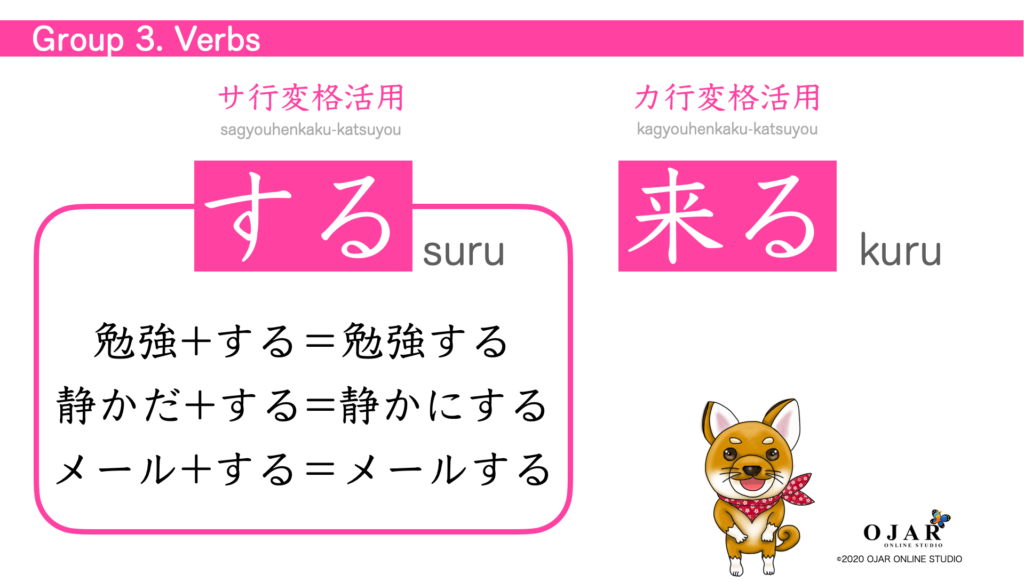
The verb conjugation of “来る” is called “カ行変格活用 KAgyou-henkaku-katsuyou” in Japanese.
The verb conjugation of “する” is called “サ行変格活用 SAgyou-henkaku-katsuyou” in Japanese.
So You can identify these words are Group 3.
■ Compounded Verbs
Compounded verbs are called “複合動詞” in Japanese.
“する suru” can make a new verb with another verb which originally existed.
■ The Answer of the Question (Group 3)

So the answers are “来る kuru”, “する suru” and “勉強する benkyousuru”.
You can learn the detail lesson “Verb Conjugation Group 3” here.
Group 2. -ru Verb
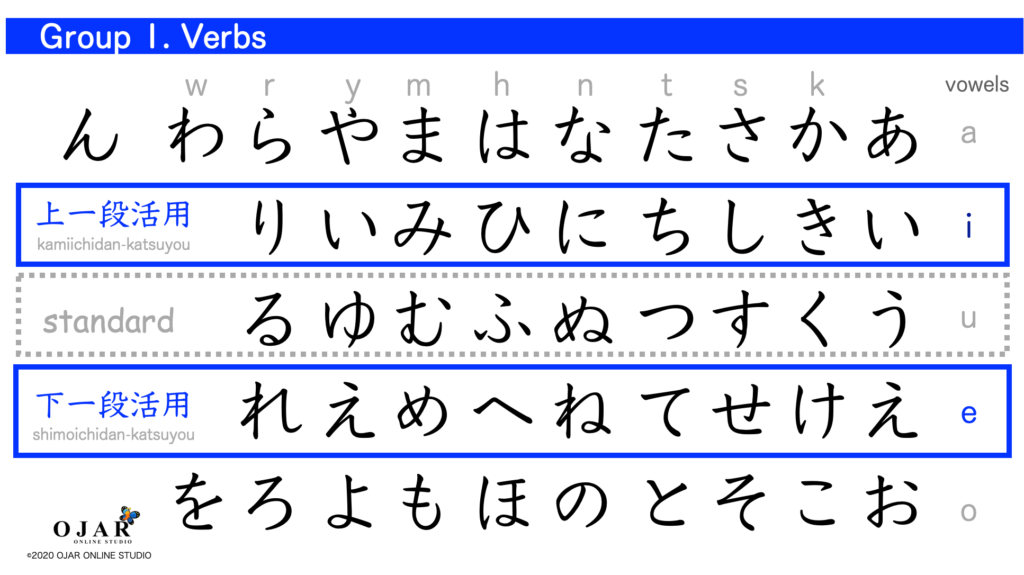
Let’s think about “-ru verb” which is classified to Group 2 here.
But actually, I don’t like this calling because it would make you confusing this naming.
So if you could, I want you to learn these ways, which are actually same as Japanese kids do.
Group 2 verbs are collected “-i sound” and “-e sound” verbs.

“-i sound” is called “上一段活用 kami-ichidan-katsuyou” in Japanese.

While “-e sound” is called “下一段活用 shimo-ichidan-katsuyou” in Japanese.
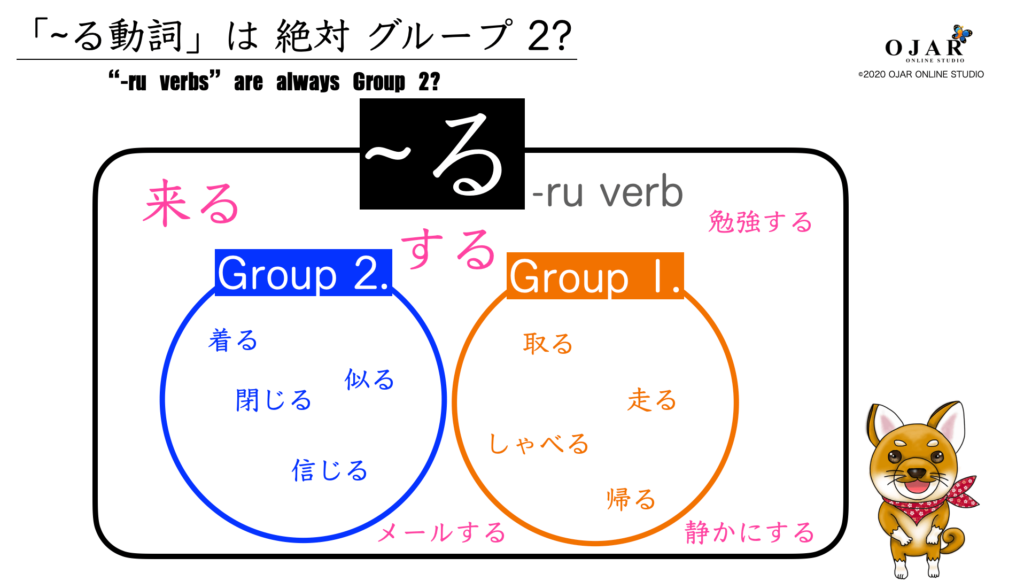
The feature is that every group 2 verb ends with “る ru”.
However, “-ru verbs” are NOT ALWAYS Group 2, you know.
■ Exceptions
1. Group 1 Verbs
As I mentioned before, there are exceptions of verbs belonging in Group 1 even if they end with “る ru”.
You should memorize these verbs as exceptions from beginner’s level to Intermediate’s level of Japanese.
They all are called “ラ行五段活用 RAgyou-godan-katsuyou” in Japanese because the suffixes belong in “R- sounds”.
| verb [ i + る ] | pronunciation | English |
|---|---|---|
| 入る | hairu | to enter |
| 走る | hashiru | to run |
| 限る | kagiru | to limit |
| 握る | nigiru | to hand |
| 参る | mairu | to go to give up |
| 交じる | majiru | to cross |
| 遮る | saegiru | to interrupt |
| 罵る | nonoshiru | to abuse |
| 捻る | nejiru | to twist |
| 滅入る | meiru | to get depressed |
| verb [ e + る ] | pronunciation | English |
|---|---|---|
| 帰る | kaeru | to go back |
| 減る | heru | to decrease |
| しゃべる | syaberu | to speak |
| 滑る | suberu | to slip |
| 焦る | aseru | to rush |
| 蹴る | keru | to kick |
| 練る | neru | to work out |
| 嘲る | azakeru | to ridicule |
| 覆る | kutsugaeru | to overturn |
| 蘇る | yomigaeru | to revive |
I think one of the reasons why these verbs become exceptions is because there are several verbs which are same pronunciations when you use with auxiliaries.
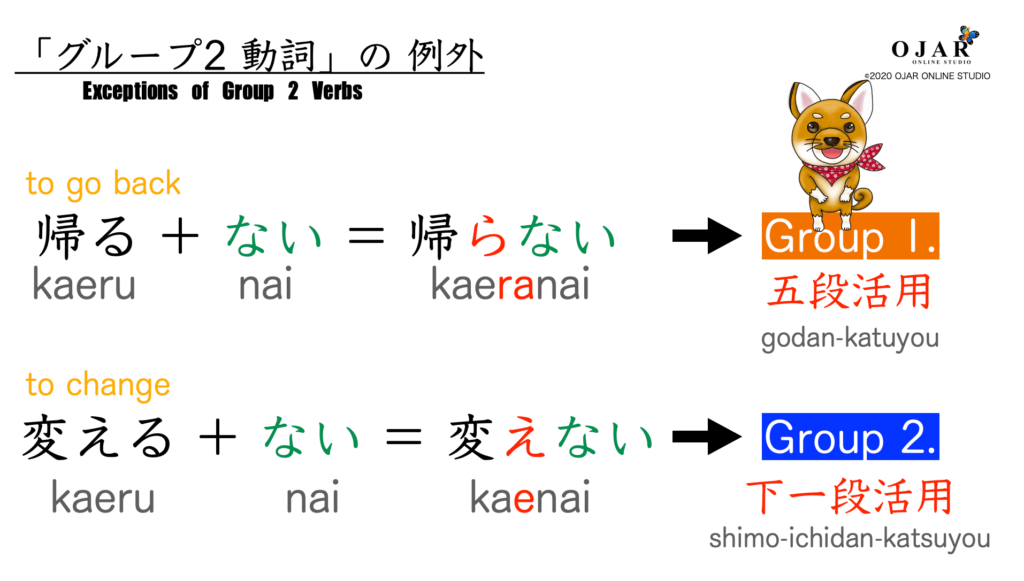
So I think we are unconditionally trying to classify these verbs clearly.
But I don’t know really the fact of the reasons.
2. Potential Verbs
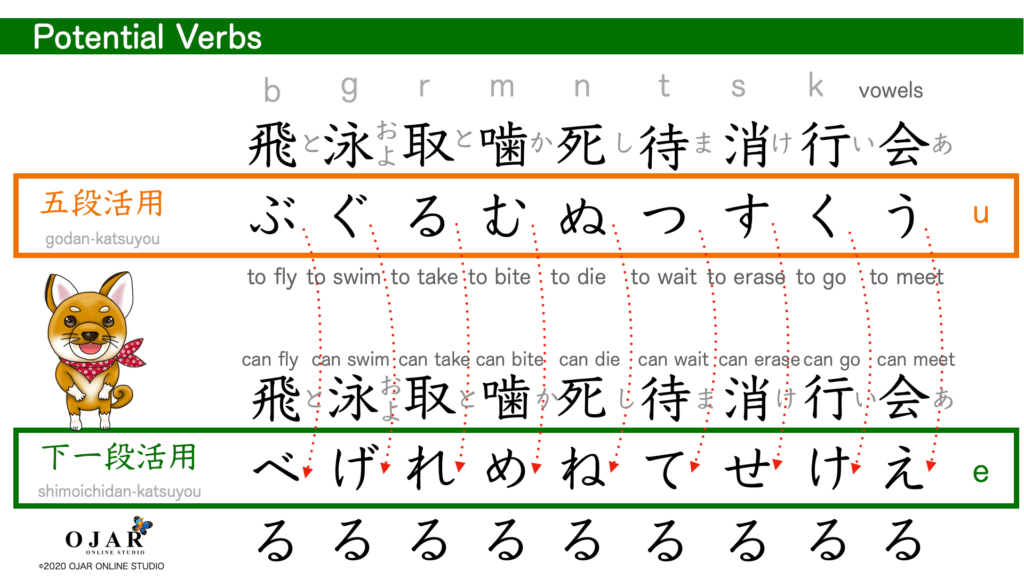
The verb showing the meaning of possible by itself in verbs is called “potential verbs”. In Japanese, it is called “可能動詞 kanoudoushi”.
Group 1 (五段活用 godan-katsuyou) verbs only become potential verbs.
The end of verbs are 【 -e sound + る 】.
Concretely, the features are “ える ける げる せる てる ねる べる める れる ”.
Besides, speaking of the conjugations, potential verbs are changed from originally Group 1 verbs ( 五段活用 ) to Group 2 verbs ( 下一段活用 ) and there is no imperative-forms.
I’m going to teach the detail lesson “Verb Conjugation 4. Potential Verbs” on the next article.
■ The Answer of the Question (Group 2)
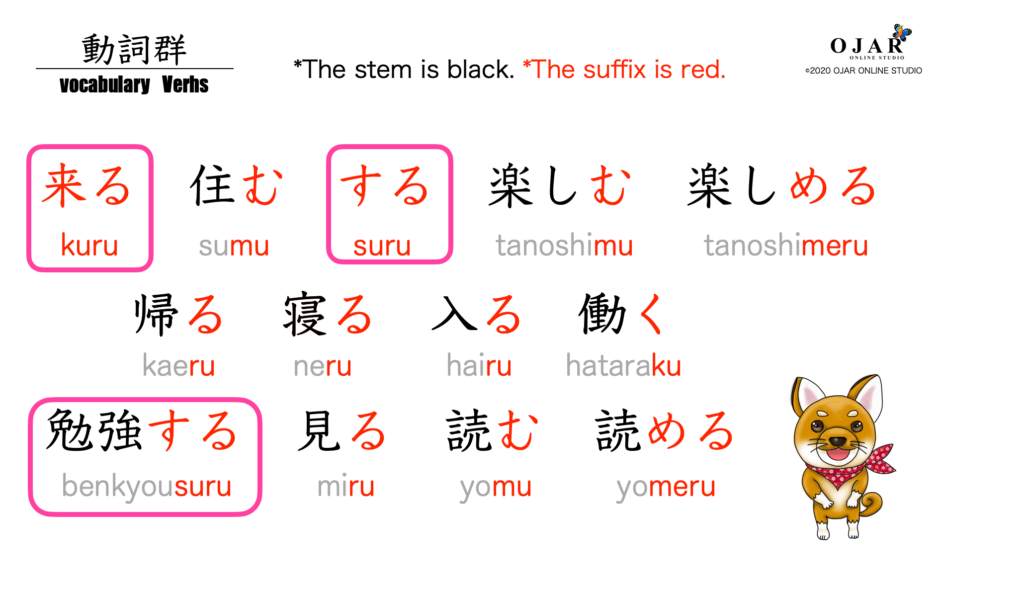
THINK ① The verbs ending with “る” are …
楽しめる 帰る 寝る 入る 見る 読める
THINK ② The verbs ending with “ -i sound” or “-e sound” are…
楽しめる tanoshimeru 帰る kaeru 寝る neru 入る hairu 見る miru 読める yomeru
THINK ③ When I remove the exceptions…
寝る 見る

Those are the answers!
You can learn the detail lesson “Verb Conjugation Group 2.” here.
Group 1. -u verb
■ The Answer of the Question (Group 1)

The other words all are Group 1verbs, so the answers are…
住む 楽しむ 楽しめる 帰る 入る 働く 読む 読める
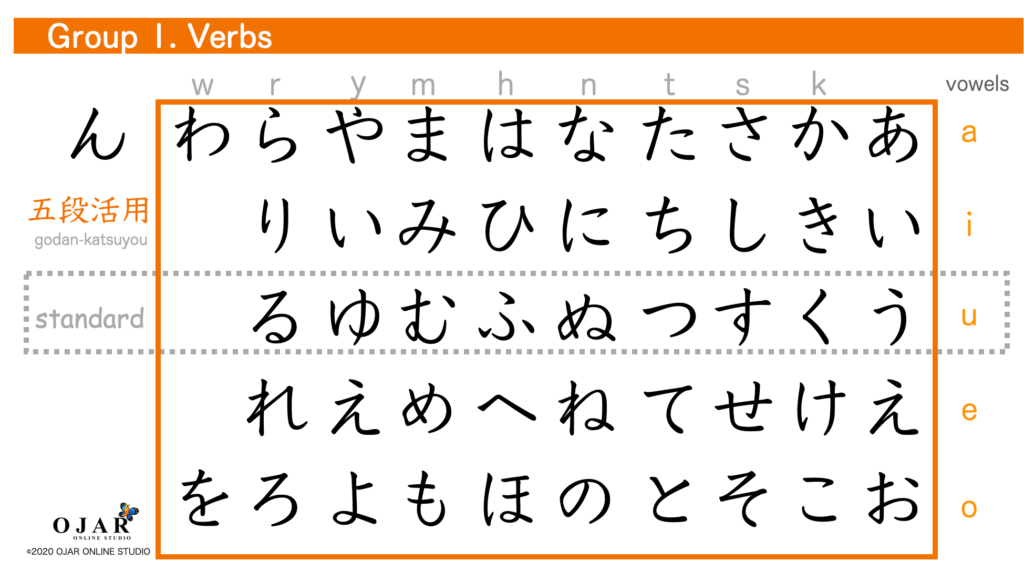
Those words are classified to Group 1, they are called “-u verb” or “vowel verb”. (You know I don’t like these names though…)
In Japan, it is called “五段活用 godan-katsuyou”.
五段活用 is collected the verbs which conjugate 5 vowel sounds. The ending of the words end with “う つ す く ぐ む ぶ ぬ or る”.
Let’s think about the answers of the question again.
THINK ① 楽しめる 帰る 読める 入る
As I mentioned before, “楽しめる” and “読める” are “potential verbs” because they end with “める”.
“入る” is the exception of “-i sound + る”, and “帰る” is the exception of “-e sound + る”.
THINK ② 住む 楽しむ 働く 読む
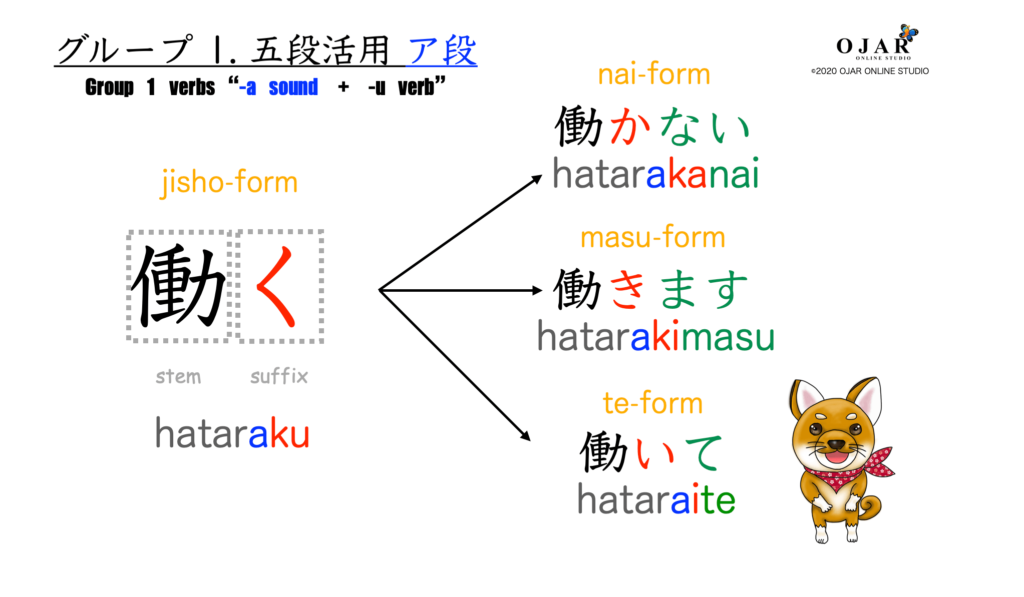
The suffix of “働く”( hataraku ) is “-a sound + -u verb”, so it’s Group 1.
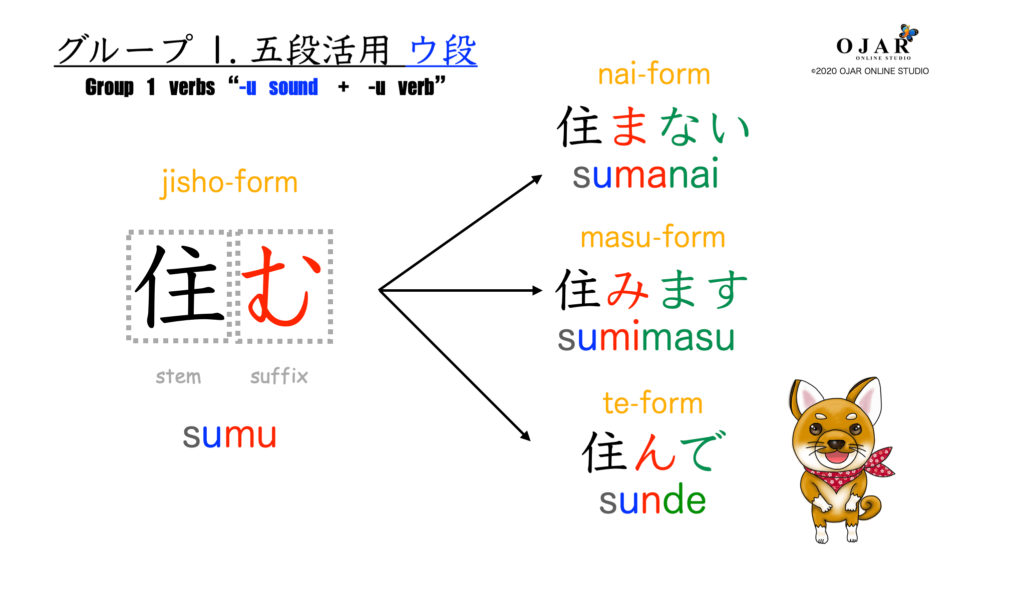
The suffix of “住む”( sumu ) is “-u sound + -u verb”, so it’s Group 1.
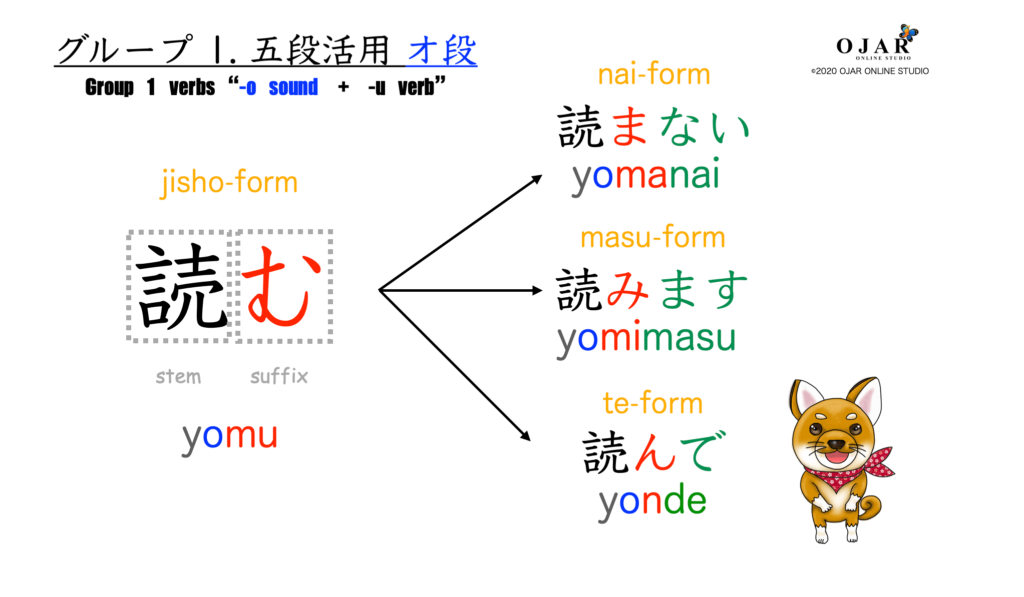
The suffix of “読む”( yomu ) is “-o sound + -u verb”, so it’s Group 1.
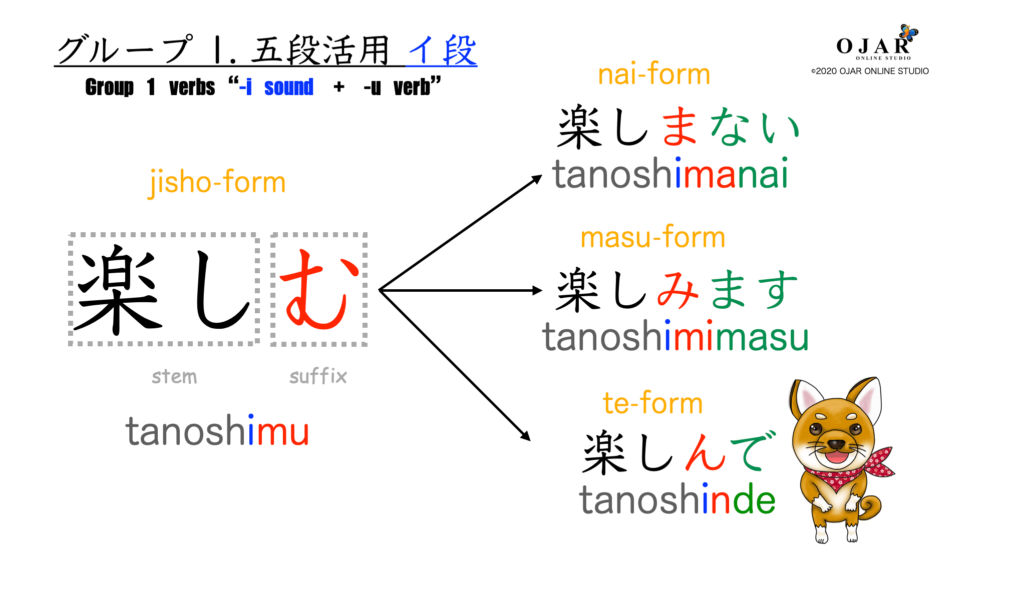
⭐️The suffix of “楽しむ”( tanoshimu ) is “-i sound + -u verb”, so it’s Group 1.
Though there isn’t this word in the question, I’m going to explain it with a picture.
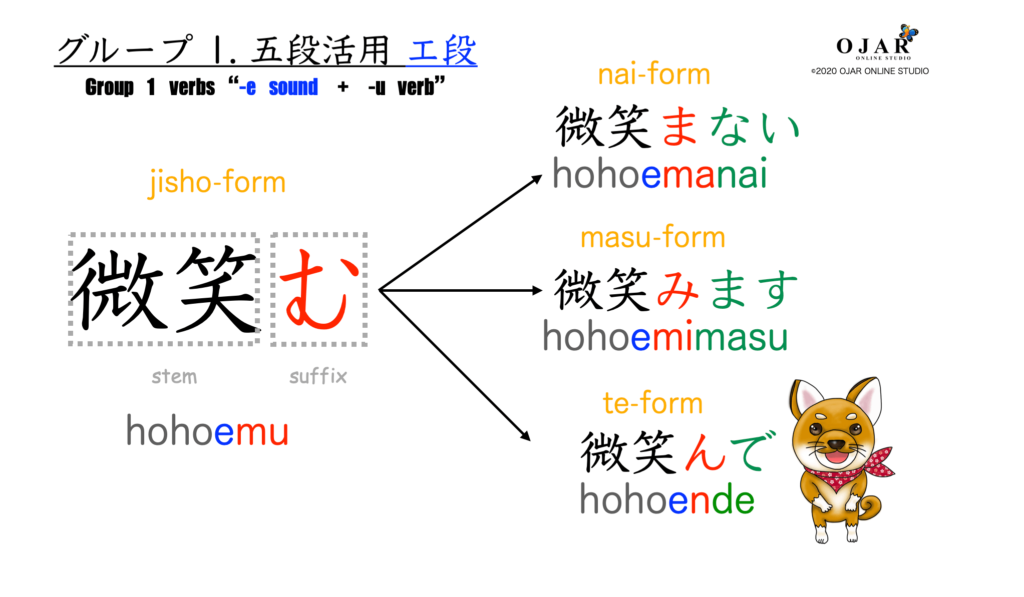
⭐️The suffix of “微笑む to smile ”( hohoeimu ) is “-e sound + -u verb”, so it’s Group 1.
You can learn the detail lesson “Verb Conjugations Group 1” here.
Okay, did you understand this lesson?
Complete Roadmap to Classify Verbs
Here is the road map to classify verbs!
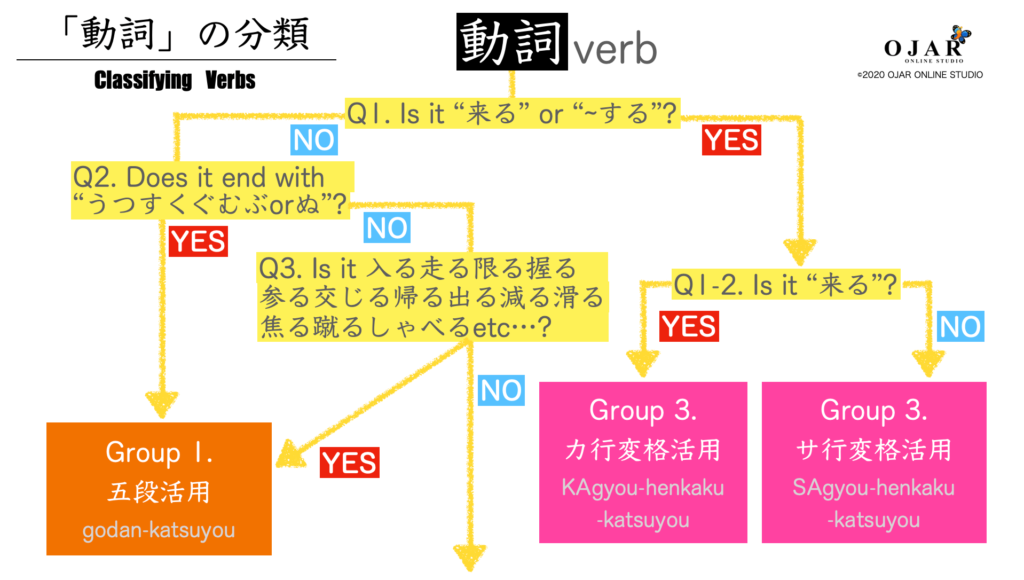
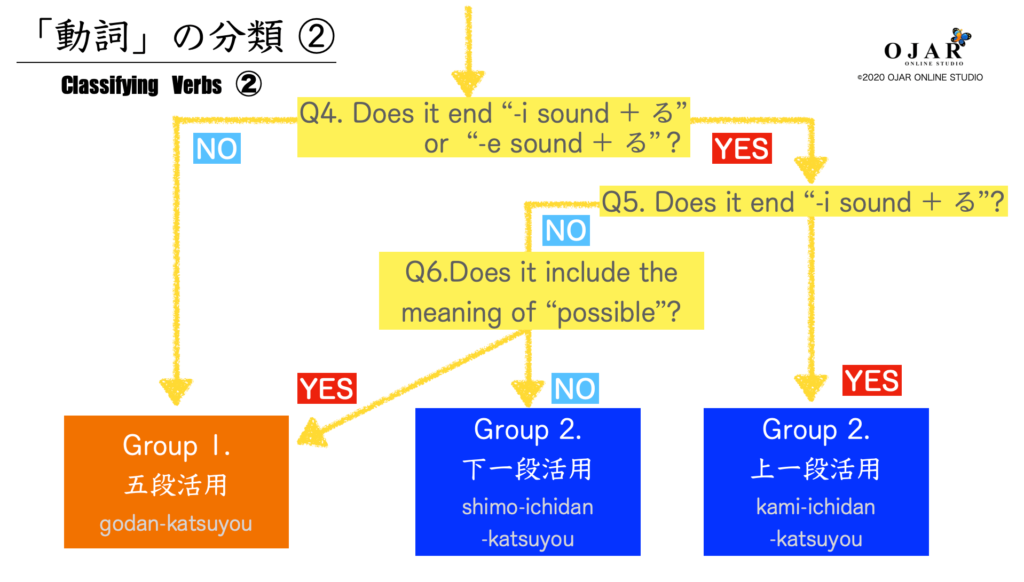
Okay, did you understand this lesson?
Let’s practice with the quiz and your homework!
Let’s Practice
Homework
✏️Answer these questions in Japanese and comment below.
Which groups do the verbs below belong in?
| ①作る |
| ②始める |
| ③宿題する |
Okay, that’s all for today!
Good luck with your Japanese study 😉
| Amazon Reviews: | ★★★★.5★ |
|---|
Published by: ジャパンタイムズ Paperback版 (1989/3/20)
P.S. My English skill is not enough yet. Please correct me with DM from CONTACT if my English is wrong. Thank you for your cooperation!
Next Lesson is; CLICK HERE!
Japanese Lesson 15: An Intransitive Verb vs A Transitive Verb
Previous Lesson is; CLICK HERE!
Japanese Lesson 13: Particles に vs で vs て

